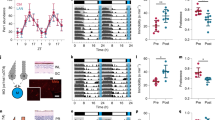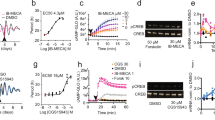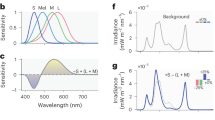Abstract
Disruption of overt circadian rhythms can occur without influencing the endogenous pacemaker, the so-called 'masking' effect classically elicited by light. As the physiological pathways involved in light masking remain elusive, we analyzed mice lacking the dopamine D2 receptor. Although circadian rhythmicity was normal, D2R-null mice showed a markedly deficient light masking response, indicating that D2R-mediated signaling is an essential component of the neuronal pathways leading to light masking of circadian rhythms.
This is a preview of subscription content, access via your institution
Access options
Subscribe to this journal
Receive 12 print issues and online access
$209.00 per year
only $17.42 per issue
Buy this article
- Purchase on Springer Link
- Instant access to full article PDF
Prices may be subject to local taxes which are calculated during checkout


Similar content being viewed by others
References
Devlin, P.F. & Kay, S.A. Annu. Rev. Physiol. 63, 677–694 (2001).
Cermakian, N. & Sassone-Corsi, P. Curr. Opin. Neurobiol. 12, 359–365 (2002).
Mrosovsky, N. Chronobiol. Int. 16, 415–429 (1999).
Witkovsky, P. Doc. Ophthalmol. 108, 17–40 (2004).
Iuvone, P.M., Galli, C.L., Garrison-Gund, C.K. & Neff, N.H. Science 202, 901–902 (1978).
Nir, I., Haque, R. & Iuvone, P.M. Brain Res. 870, 118–125 (2000).
Cahill, G.M. & Besharse, J.C. J. Neurosci. 11, 2959–2971 (1991).
Steenhard, B.M. & Besharse, J.C. J. Neurosci. 20, 8572–8577 (2000).
Missale, C., Nash, S.R., Robinson, S.W., Jaber, M. & Caron, M.G. Physiol. Rev. 78, 189–225 (1998).
Vallone, D., Picetti, R. & Borrelli, E. Neurosci. Biobehav. Rev. 24, 125–132 (2000).
Baik, J.H. et al. Nature 377, 424–428 (1995).
Yujnovsky, I., Hirayama, J., Doi, M., Borrelli, E. & Sassone-Corsi, P. Proc. Natl. Acad. Sci. USA 103, 6386–6391 (2006).
Sakamoto, K. et al. Eur. J. Neurosci. 22, 3129–3136 (2005).
Hattar, S. et al. Nature 424, 75–81 (2003).
Klein, D.C. et al. Recent Prog. Horm. Res. 52, 307–357 (1997).
Acknowledgements
M.D. is supported by Japan Society for the Promotion of Science Postdoctoral Fellowships for Research Abroad; I.Y. by a fellowship from the Association pour la Recherche sur le Cancer; and J.H. by a fellowship from the Fondation pour la Recherche Médicale. This work and M.M. and E.T. were supported by the EC LSHM-CT-2004-005166 grant. Additional funds are from Fondation de France, Centre National de la Recherche Scientifique, Institut National de la Santé et de la Recherche Médicale, Centre Hospitalier Universitaire Régional, Fondation de la Recherche Médicale, Université Louis Pasteur, Electricité de France, Association pour la Recherche sur le Cancer and La Ligue Contre le Cancer.
Author information
Authors and Affiliations
Corresponding authors
Ethics declarations
Competing interests
The authors declare no competing financial interests.
Supplementary information
Supplementary Fig. 1
Light induction of mPer1 is reduced in the retina of D2R knock-out mice. (PDF 189 kb)
Supplementary Fig. 2
Generation of a specific antibody against D2R. (PDF 270 kb)
Supplementary Fig. 3
Immunofluorescence showing the localisation of the D2 Receptor in the mouse retina. (PDF 587 kb)
Supplementary Fig. 4
Photic induction of mPer1 in the SCN. (PDF 187 kb)
Supplementary Fig. 5
Visually-driven behaviors of D2R−/− mice. (PDF 199 kb)
Supplementary Table 1
Phenotypic characteristics of D2R knock-out mice (PDF 69 kb)
Rights and permissions
About this article
Cite this article
Doi, M., Yujnovsky, I., Hirayama, J. et al. Impaired light masking in dopamine D2 receptor–null mice. Nat Neurosci 9, 732–734 (2006). https://doi.org/10.1038/nn1711
Received:
Accepted:
Published:
Issue Date:
DOI: https://doi.org/10.1038/nn1711
This article is cited by
-
Sex Differences in Long-term Outcome of Prenatal Exposure to Excess Glucocorticoids—Implications for Development of Psychiatric Disorders
Molecular Neurobiology (2023)
-
Dopamine Receptor Expression and the Pathogenesis of Attention-Deficit Hyperactivity Disorder: a Scoping Review of the Literature
Current Developmental Disorders Reports (2022)
-
Bright light improves sleep in patients with Parkinson’s disease: possible role of circadian restoration
Scientific Reports (2020)
-
Dopamine: Functions, Signaling, and Association with Neurological Diseases
Cellular and Molecular Neurobiology (2019)
-
Genetics and epigenetics of circadian rhythms and their potential roles in neuropsychiatric disorders
Neuroscience Bulletin (2015)



